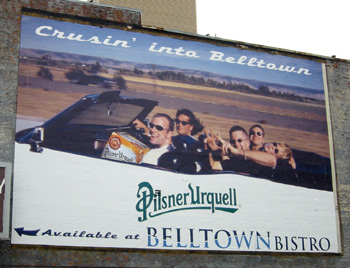layers of time in belltown
[repost from 2006]

Ugh.
I’m really getting old. I don’t feel old, and I don’t think I look that old, but I’ve been around long enough that I have fond memories of the way things used to be. There’s a point in time stuck in my mind, a zeitgeist.
For me, the Belltown of the early 90s will be the true Belltown forever. Like how people talk about the Left Bank, or places in Paris frequented by the Surrealists, Belltown is fixed—preserved—as a place of creativity, individuality, possibility. When I see the showy remodeled bars and clubs, when I look at The Frontier Room, I don’t see “sexy crushed velvet furniture,” as NWsource puts it, I see the entry to one of the sleaziest dives in the city, where you could get Red Death for free on your birthday, get thrown out by the dyke bartender for stealing tips, or play pool with heroin addicts soon to make it big on Sub Pop.
My formative Belltown experience was attending the opening of World Pizza, run by a couple of brothers just starting out, trying something new. We had just moved into the neighborhood. Locals were hanging out on the sidewalk drinking wine and sharing spliffs. It was summer, and we hooked up with some artists living at the Rivoli apartments. It was one of those magical nights where you meet some strangers, stay up and talk all night, getting more and more excited at the possibilities, then stumble out into the gray dawn as dear friends, maybe headed to coffee at the old Cyclops or Penny University.
It was Bohemian in the strictest sense of the word. Rent was cheap enough to allow poets and filmmakers to run bookstores selling vintage Burroughs or hand-bound art books, little coffee shops that probably took in $100 a day and still got by. The solution to “what should we do for dinner tonight?” was not to head to the latest Tom Douglas juggernaut for anise-infused pork cheeks, but to walk to Ralph’s on 4th & Virginia, past the BGD crews (Black Gangster Disciples), and get makings for a potluck in someone’s studio apartment.
I don’t mean to be bathetic. What’s interesting to me is the sense that Belltown, in fact the whole city, is existing in many time zones. The New has been perfunctorily overlayed, allowing a few places in the old time zone to shine through. The Rendezvous comes to mind—they remodeled, and the cirrhotic regulars are gone, but they left the peeling wallpaper in the Jewel Box Theatre, where home-grown burlesque shows are still performed. The reincarnated Cyclops shimmers between the old and the new as well.
Actually there are quite a few places that manage to channel some of the old Belltown soul: Mama’s, Roq La Rue, Shorty’s, Lava Lounge, Crocodile, Noodle Ranch, Cyclops, VAIN, Two Bells, and APEX Co-op among them. These have held their own, sitting squat and fast, despite the condos erupting around them, despite the fire that took out gems like The 211 Club and Speakeasy.
But in other places the integration of The New cuts deeper. The Austin A. Bell building stood empty through the 80s and 90s, a majestic artifact of the previous century that leant a desolate beauty to First Avenue. In 1997 it was all but demolished, leaving only the face of the building, and Starbucks moved in downstairs. Bethel Temple, where the homeless used to get food or clothing handouts, is now a 24-story office tower sporting only a shell of the 1915 Italian Renaissance façade.
Meanwhile, more layering happens throughout the city in Ballard, Georgetown, Columbia City, Beacon Hill. I don’t want to be one of those middle-aged people stuck in the past, but I’ll continue to be drawn to smaller places that inspire individuality and creativity. If a little dust and sleaziness shows through, so much the better.
Read more about the history of Belltown in the 80s and 90s with archives of interviews in the Belltown Messenger.